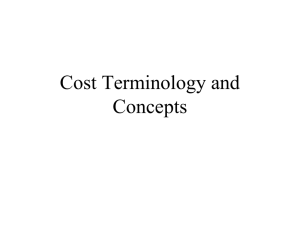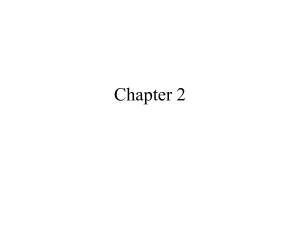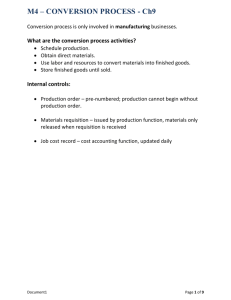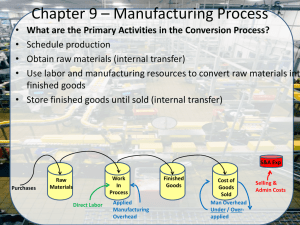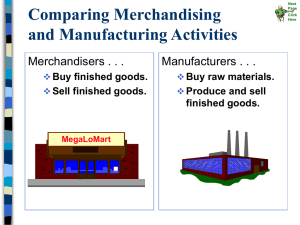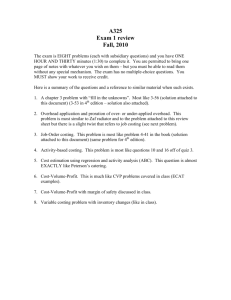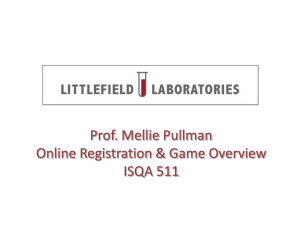Chapter 9
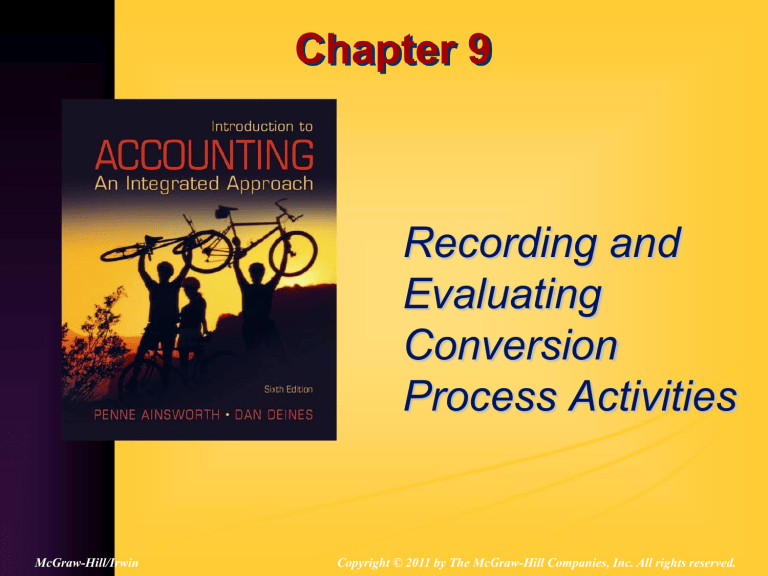
McGraw-Hill/Irwin
Chapter 9
Recording and
Evaluating
Conversion
Process Activities
Copyright © 2011 by The McGraw-Hill Companies, Inc. All rights reserved.
9-2
What are the Primary Activities in the Conversion Process?
• Schedule production
• Obtain raw materials (internal transfer)
• Use labor and manufacturing resources to convert raw materials into finished goods
• Store finished goods until sold (internal transfer)
9-3
Which of the Conversion Process
Activities are Accounting Events?
• Obtain raw materials
Increase work-in-process inventory
Decrease direct materials inventory
• Use labor and overhead
Increase work-in-process inventory
• Store finished goods
Increase finished goods inventory
Decrease work-in-process inventory
9-4
What is the Basic Flow of Information in the Conversion Process?
• Customer places an order and production is scheduled
• Raw materials are requisitioned and recorded
• Labor is used and recorded
• Cost record prepared and goods are manufactured
• Goods are finished and recorded
9-5
What are the Manufacturing
Inventory Accounts?
• Direct materials inventory
Current asset (similar to Merchandise
Inventory for a merchandising company):
Cost of direct materials on hand
Increases when purchases of direct materials are made (Chapter 8)
Decreases when direct materials are requisitioned into production
9-6
Inventories Continued
• Work-in-process inventory
Current asset: Cost of products that have been started but not completed
Increases when direct materials are requisitioned into production
Increases when direct labor is used in production
Increases when manufacturing overhead is applied to production
Decreases when products are finished
9-7
Inventories Continued
• Finished goods inventory
Current asset: Cost of products that have been finished but not sold
Increases when products are finished
Decreases when products are sold (Chapter
10)
9-8
How do Costs Flow through the
Inventory Accounts?
Beginning direct materials inventory
+ Purchases of direct materials
= Cost of direct materials available for use
Direct materials issued into production
= Ending direct materials inventory
9-9
Cost Flows Continued
Beginning work-in-process inventory
+ Direct materials issued into production
+ Direct labor used in production
+ Applied manufacturing overhead
= Cost of goods in process
Cost of goods manufactured
= Ending work-in-process inventory
9-10
Cost Flows Continued
Beginning finished goods inventory
+ Cost of goods manufactured
= Cost of goods available for sale
Cost of goods sold
= Ending finished goods inventory
9-11
How does the Manufacturing
Overhead Application Process Work?
• Beginning of period
Estimate overhead for each cost pool
• Unit-related
• Batch-related
• Product-sustaining
• Facility-sustaining
Estimate cost drivers for each cost pool
Divide estimated overhead by estimated cost driver = predetermined overhead rate
9-12
Overhead Application Continued
• During period
Apply overhead to production as the cost driver is used
Record actual overhead as incurred
• End of period
Compare total applied overhead to total actual overhead
Close the overhead account to Cost of Goods
Sold (difference between applied and actual)
9-13
What are Variances?
• Difference between the standards and the actual prices or quantities
• Direct labor variances
Direct labor price variance
Direct labor usage variance
• Direct material variances
Direct material price variance
Direct material usage variance
Direct material inventory variance
9-14
How are Direct Labor Variances
Calculated?
• Direct labor price variance
(SP – AP) * AH
Tells us whether we paid more or less for labor than anticipated (budgeted)
• Direct labor usage variance
(AH – SHa) * SP
Tells us whether we worked more or less hours than planned given the number of units produced
9-15
How are Direct Material Variances
Calculated?
• Direct materials price variance
(AP – SP) * AQp
Tells us whether we paid more or less for direct materials than anticipated (budgeted)
• Direct materials usage variance
(AQu – SQa) * SP
Tells us whether we used more or less direct materials than planned given the number of units produced
• Direct materials inventory variance
(AQp – AQu) * SP
Tells us whether inventory levels are increasing or decreasing
